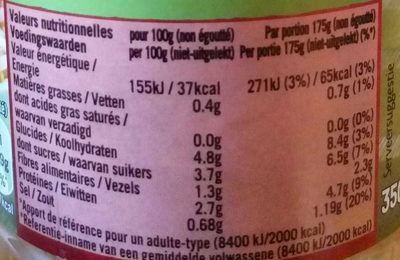Pousses de Mungo Mungosprossen - Suzi Wan - 350g
This product page is not complete. You can help to complete it by editing it and adding more data from the photos we have, or by taking more photos using the app for Android or iPhone/iPad. Thank you!
×
Barcode: 4002359206306 (EAN / EAN-13)
Quantity: 350g
Brands: Suzi Wan
Categories: Plant-based foods and beverages, Plant-based foods, Legumes and their products, Canned foods, Legumes, Seeds, Canned plant-based foods, Legume seeds, Fresh foods, Pulses, Fresh plant-based foods, Sprouts, Canned sprouts, Fresh sprouts, Canned legume sprouts, Fresh legume sprouts, Sprouted mung beans, Canned mung bean sprouts, Fresh mung bean sprouts
Manufacturing or processing places: Pays-Bas
Stores: Intermarché
Countries where sold: France, Germany, Switzerland, United States
Matching with your preferences
Environment
Carbon footprint
Packaging
Transportation
Report a problem
Data sources
Product added on by date-limite-app
Last edit of product page on by foodvisor.
Product page also edited by ecoscore-impact-estimator, kiliweb, lauryne59, moon-rabbit, openfoodfacts-contributors, packbot, prepperapp, quechoisir, sebleouf, tacite-mass-editor, viedock, yuka.UlBsWU5JNGlodjRBZzlvYjhpSHo0LzFTNk1TeVQwam5KYzRjSVE9PQ, yuka.YTRFS0NyMHRyY2tJa2NRNnd4YjIwL1JvMzRDRmZrU3pBdFVRSWc9PQ, yuka.sY2b0xO6T85zoF3NwEKvlhF6dMb9hW6eHT_hoHza5Mq0P6DLPNRcztjCNKs, yuka.sY2b0xO6T85zoF3NwEKvllMYTuXz_xfIbTnSqW3V7_mAdLP2WY9Twob_Das, yuka.sY2b0xO6T85zoF3NwEKvlmVMCsv9nmmcPk35o0us24-TFoS2XtsjybXabao, yuka.sY2b0xO6T85zoF3NwEKvlmlsVMH6piz0DSXlgVW34-m3IrHLSNVj-K35N6s.










